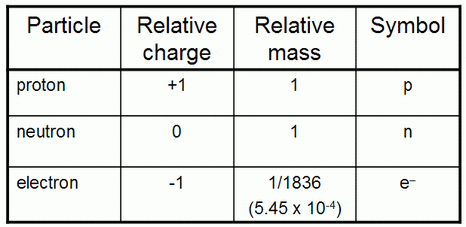The world of subatomic particles is a realm that captivates both scientists and enthusiasts alike. It is within this enigmatic domain that boundaries of the known universe blur, leading to a multitude of intriguing questions. A pivotal query arises: are there more than 61 subatomic particles? This question not only stirs intellectual curiosity but also serves as a gateway to deeper explorations of the fundamental constituents of matter.
The Standard Model of particle physics, a well-established framework, provides an impressive catalog of known subatomic particles. It includes quarks, leptons, gauge bosons, and the elusive Higgs boson. The standard perception is that there are 61 distinct particles within this framework; however, this is merely the beginning of a more complex and fascinating narrative. As one delves deeper into the subatomic world, the notion of “particles” becomes increasingly elaborate.
Subatomic particles can be categorized into two primary groups: fermions and bosons. Fermions, which include quarks and leptons, are the building blocks of matter. They follow the Pauli exclusion principle, allowing only one particle to occupy a given quantum state simultaneously. This characteristic fundamentally shapes the structure of atoms, and by extension, all matter we observe. Bosons, on the other hand, are force carriers that mediate interactions between fermions. They do not adhere to the exclusion principle, which permits multiple bosons to coexist in the same state. This fundamental distinction is crucial to understanding the complex interactions at play within the subatomic domain.
The quarks, fundamental constituents of protons and neutrons, emerge in six flavors: up, down, charm, strange, top, and bottom. Each quark flavor possesses unique properties, such as electric charge and mass, making them fundamental to the formation of atomic nuclei. The beauty of quarks resides not only in their diversity but also in their peculiar behavior; they are never found in isolation, a phenomenon known as color confinement. The representation of their combinations leads to a staggering array of composite particles—hadrons, including baryons and mesons—that far exceed the seemingly simple count of elementary particles.
Leptons, consisting of electrons, muons, tau particles, and their corresponding neutrinos, further enhance the particle portfolio. Notably, neutrinos are produced in copious amounts from stellar processes yet interact feebly, making them elusive. The study of neutrinos has unveiled intriguing phenomena such as neutrino oscillation, suggesting the existence of additional particle families and prompting theorists to ponder whether the known particles represent merely the tip of the proverbial iceberg.
The inquiry into the existence of particles beyond the 61 listed in the Standard Model invokes the concept of supersymmetry (SUSY). Supersymmetry posits a mirror counterpart for each particle, effectively doubling the particle count. For every fermion, there exists a bosonic superpartner, and vice versa. Although direct experimental evidence for SUSY remains elusive, its theoretical elegance continues to inspire researchers to examine the nuances of particle physics, thereby broadening the scope of exploration well beyond the established parameters.
Moreover, the realm of speculative theories introduces concepts such as string theory, which envisions that fundamental particles are not point-like objects but rather tiny, vibrating strings. This revolutionary perspective could lead to an infinite variety of particle types, challenging the very foundation of the current framework and suggesting an inexhaustible arsenal of subatomic configurations. The allure of string theory lies in its potential to unify gravity with quantum mechanics, a dream long sought by physicists and a step towards a “theory of everything.”
The search for particles beyond the known framework also intertwines with the mysteries of dark matter and dark energy, phenomena that account for a significant portion of the universe’s composition yet remain poorly understood. While the Standard Model successfully describes the known particles, it does not offer an explanation for the behaviors attributed to dark matter. Hypothetical particles like axions and WIMPs (Weakly Interacting Massive Particles) are proposed candidates, sparking ongoing research endeavors aimed at uncovering the true nature of the cosmos.
Astrophysical observations suggest that the universe may harbor more than the familiar particles we have come to recognize. The existence of additional, as yet undetected particles would challenge our concepts of symmetry, conservation laws, and the standard interactions that govern particle behavior. The potential ramifications of confirming the existence of new particles could lead to a paradigm shift within the field of physics, enriching our comprehension of the universe.
In addition to the theoretical exploration of subatomic particles, advancements in experimental techniques have paved the way for groundbreaking discoveries. Particle accelerators, like the Large Hadron Collider (LHC), facilitate unprecedented collisions at immense energies, potentially revealing new particles that lie hidden within the fabric of matter. Each detection not only bolsters understanding but also provokes further inquiries into particle phenomena that extend beyond established knowledge.
In conclusion, the question of whether there exists more than 61 subatomic particles transcends a simple quantitative assessment. It opens a dialogue about the very nature of reality. This fascinating inquiry beckons us to consider the myriad ways in which the universe operates at its most fundamental level. As science continues to evolve, it is likely that our particle catalog will expand, introducing new wonders while simultaneously challenging our assumptions about existence. The pursuit of knowledge in this field serves to deepen our respect for the complexities of the universe, and as researchers unravel its mysteries, the list of known subatomic particles may very well become an ever-growing testament to the boundless curiosity of the human spirit.












